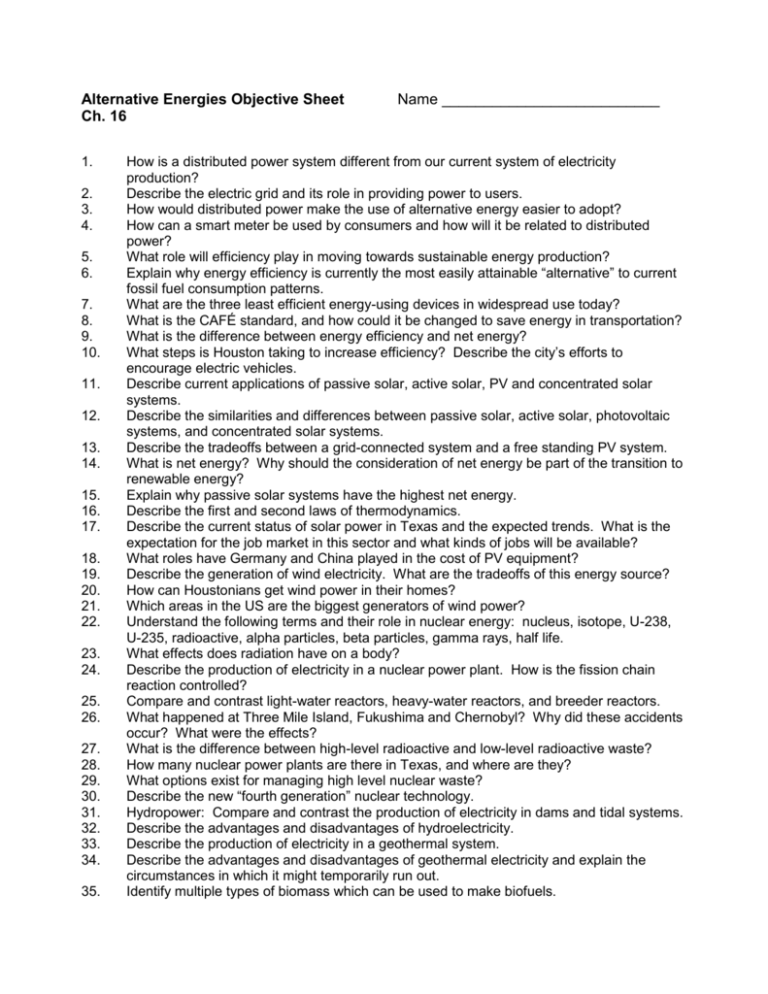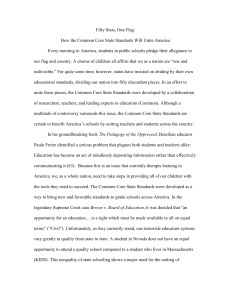Atmospheric Issues * Objective Sheet
advertisement

Alternative Energies Objective Sheet Ch. 16 1. 2. 3. 4. 5. 6. 7. 8. 9. 10. 11. 12. 13. 14. 15. 16. 17. 18. 19. 20. 21. 22. 23. 24. 25. 26. 27. 28. 29. 30. 31. 32. 33. 34. 35. Name __________________________ How is a distributed power system different from our current system of electricity production? Describe the electric grid and its role in providing power to users. How would distributed power make the use of alternative energy easier to adopt? How can a smart meter be used by consumers and how will it be related to distributed power? What role will efficiency play in moving towards sustainable energy production? Explain why energy efficiency is currently the most easily attainable “alternative” to current fossil fuel consumption patterns. What are the three least efficient energy-using devices in widespread use today? What is the CAFÉ standard, and how could it be changed to save energy in transportation? What is the difference between energy efficiency and net energy? What steps is Houston taking to increase efficiency? Describe the city’s efforts to encourage electric vehicles. Describe current applications of passive solar, active solar, PV and concentrated solar systems. Describe the similarities and differences between passive solar, active solar, photovoltaic systems, and concentrated solar systems. Describe the tradeoffs between a grid-connected system and a free standing PV system. What is net energy? Why should the consideration of net energy be part of the transition to renewable energy? Explain why passive solar systems have the highest net energy. Describe the first and second laws of thermodynamics. Describe the current status of solar power in Texas and the expected trends. What is the expectation for the job market in this sector and what kinds of jobs will be available? What roles have Germany and China played in the cost of PV equipment? Describe the generation of wind electricity. What are the tradeoffs of this energy source? How can Houstonians get wind power in their homes? Which areas in the US are the biggest generators of wind power? Understand the following terms and their role in nuclear energy: nucleus, isotope, U-238, U-235, radioactive, alpha particles, beta particles, gamma rays, half life. What effects does radiation have on a body? Describe the production of electricity in a nuclear power plant. How is the fission chain reaction controlled? Compare and contrast light-water reactors, heavy-water reactors, and breeder reactors. What happened at Three Mile Island, Fukushima and Chernobyl? Why did these accidents occur? What were the effects? What is the difference between high-level radioactive and low-level radioactive waste? How many nuclear power plants are there in Texas, and where are they? What options exist for managing high level nuclear waste? Describe the new “fourth generation” nuclear technology. Hydropower: Compare and contrast the production of electricity in dams and tidal systems. Describe the advantages and disadvantages of hydroelectricity. Describe the production of electricity in a geothermal system. Describe the advantages and disadvantages of geothermal electricity and explain the circumstances in which it might temporarily run out. Identify multiple types of biomass which can be used to make biofuels. 36. 37. Evaluate the use of corn to create biofuels (biodiesel and ethanol). Describe the basic features of a LEED building. Explain the significance of third party certification. Mon Tue Mar 3 Wed Mar CH 16 PPT HW: Objs 1-10 & Read Ch 16 Mon Mar Tue Mar 10 Wed Mar Stamp 11-20 Energy Project Handed out Lab HW: Finish Objs Mon Mar 16 SPRING BREAK Mon Mar Tue Mar 17 SPRING BREAK Tue Mar 24 Thur Mar 5 Stamp Objs Decentralized vs centralized energy Finish Ch 16 Wind Energy Intro Lab HW: Objs 1120 Thur Mar 12 Fri Mar Finish Lab 7 Review Solar Energy Nuclear Energy Wed Mar 18 Thur Mar 19 SPRING BREAK SPRING BREAK Wed Mar Thur Mar 26 Energy Presentations Key Terms active solar heating system cogeneration combined heat and power systems (CHP) energy efficiency geothermal energy passive solar heating system photovoltaic (PV) cells solar cells Fri Mar 6(B) Review Lab Due Fri Mar 20 SPRING BREAK Fri Mar 27(B) TEST All Objs Due









